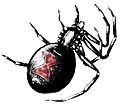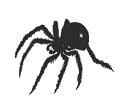
Clinical Pattern and Diagnostic
of the BLACK WIDOW Spider Bites

![]() Habitation Area and Specimen Description | Methodic of Urgent Aid and Treatment
Habitation Area and Specimen Description | Methodic of Urgent Aid and Treatment ![]()
 |
Clinical Pattern and Diagnostic
|
 |
|
|
The Black Widow poison bears neurotoxic features, speads through the lymph system and contains about half a dozen active components with molecular weight from 5.000 to 130.000 Daltons. The poison strikes the membranes of neuron motoric receptors in neuro-muscular synapses which remains open the channels for incoming flow of ionized Sodium (Na+), and causes formation of acethylcholine and norepynephryne (adrenalyne rush) and attenuates the reversal chemical reactions. It results to extra stimulation in the ganglias of motoric muscular neurons.
The bite by female Black Widow causes the complex of symptoms known as (LATRODECTISM).
Local appearance of the bite is associated with developing two tiny red spots at the location of the bite and slight discoloring of skin for red with miscellaneous edematic spots and local dumbness. Symptomatics development is delayed and takes from 15 minutes to 6 hours. Generally, the less is interval between the bite and symptoms development the more severe is clinical pattern.
Systematic appearances: a heavy pain emergence at the location of the bite which passes quickly, but in some time (15 minutes - 6 hours) intense pain catches the entire biten limb which further captures body muscles, chest muscles (pronounced breath difficulty), abdominal muscles. The pain is so severe, that in some cases the physicians erroneously diagnose the heart attack or "sharp belly". The expressed muscular tensions, fasciculatory rmuscular reductions join to the pain later. Last involved are muscles of face: sweating, distorted with pain with lacrimation and blepharoconjunctivites face is known as "Facies LATRODECTISMICA".
Nausea, weakness, hyperesthesia, convulsion, excessive sweating and extreme disturbance may be also observed. The symptoms usually last for 24-48 hours but in severe cases they may take far longer periods - up to few days.As regards the cariovascular and breathing systems hypertension, tachicardia, bronchorea and breath difficulties may be observed. Among the other simptoms may be marked "Pavor mortis", expressed death fear, vomitting, priapism, urine delays, thirst, salivation, convulsions, eventual speech difficulties and, very seldom, pruritus and breaking dut.
Laboratory analysis may show leukocytosis, hyperglikemy and creatinphosphocinase increase.
Lethal outcome is most probable among children or adults suffering severe background ailments or hospitalized after long delay and amounts, probably, to 4% - 6% of total amount of those biten - giving a high rate.
Diagnostic and Treatment Procedures in Case of Insects Bites
(Honeybees, Wasps, Hornets, Spiders and Arachnoidae)
The striking effect is delivered by means of bite or stinging by means of wounding appliances (sting with the insects) which is stucturally and functionally connected with venom-poducing gland and discharging channels. The primary zootoxine depot is formed at the location of the bite, from where the venom is spread through the entire ody via the lymphatic and vascular systems. The toxic effect is generally determined by stiking the life-supporting systems: nervous, breathing, cardiovascular, blood coagulation system, liver and kidneys disfunctions or failures typical for this pathology. Among about 2% of patients display allergical reactions up to anaphylactic shock.
THERAPY TACTICS IN CASES OF BITES BY BEES, WASPS AND HORNETS.
Аntihistaminic medicines, such as (Dimedrol, Suprastini or their analogs to be introduced either intra-intestinal or intra-vascular.
Prednizoloni 30-60 mg intravascular.Locally, Troxivasini gel, corticosteroid oinments.
In case of development of anaphylactoid reactions - intense treatment procedures.
|
DIAGNOSTICAL DISCREPANCIES IN ARACHNOIDAE BITES |
|||
| Black Widow Bite: Black Widow venom contains neurotoxines of albuminous origin (healuronidazae, kininazae, phosphodisterazae, cholyneestherazae). |
 |
Tarantula Bite: Tarantula venom contains toxic peptides (Sperminae, Spermidinae, Putrescinae), which affects the differences in toxic effects. |
 |
| 1. Contact with big black-coloured spider (fair coloured specimen may occur, too). | 1. Contact with very big spider with fluffed brindled belly. | ||
| 2. Pain in the bite location ceases soon. | 2. Pain at the bite location lasts for entire day. | ||
| 3. Bite location is slightly painful. During sleeping the bite may be unnoticed. |
3. Immediate severe pain at the bite location. | ||
| 4. Places of nails penetration through the skin are unidentifiable by bare eyeing. | 4. Places of skin damage are easily identified and are 3 - 15 mm apart. | ||
| 5. Tiny red spot may be identified at the bite location. | 5. Two apparent spots show at the bite location where the skin was penetrated. | ||
| 6. No bump observed at the bite location. | 6. Spread reddiness at the bite location, eventual spread tissue oedema. | ||
| 7. Rapid disturbance, fear of death, heavy panting observed soon after bite | 7. After the bite feeling of dizziness and apathy observed. | ||
| 8. Typical heavy pains in entire body, in abdominal area, chest, loin, sharp tension in abdominal muscles. | 8. No spread pain feelings, often heaviness in spinal part of the body. | ||
Urgent Aid:
During the first 2-3 minutes Markovskiy Method may be applied - to burn the bite location with the flame of matches. For this purpose 1 - 2 matches are placed with the heads to the bite location and ignited with the third burning match. As only the top layer of skin is stroken with the bite (maximum depth 0,5 mm) the flame generated by matches is sufficient to corrupt the zootoxins components.
ВIntroduce intravenously 10-12 ml 33% ethylalcohol every 5-6 hours.
Expressed intoxication signs may be reduced by means of intravenous 10-20 ml 0,25 - 0,5 % Novocaini, 10,0 ml 10% Calcium Dichloridi, 2,5 g Sulphuric Magnesia.
Anti-Black Widow serum.
Hospitalization to the stationery with intense therapy facilities.
Desintoxicating and symptomatic therapy within the stationery treatment period.
Method 1 | Method 2 | Method 3 | SODIUM HYPOCHLORID
|
Index | About the Project | Authors | Know How | Useful Reference | Site Map | Up |
|
© 2005-2021, Sergiy I. Shatilov, MD. |